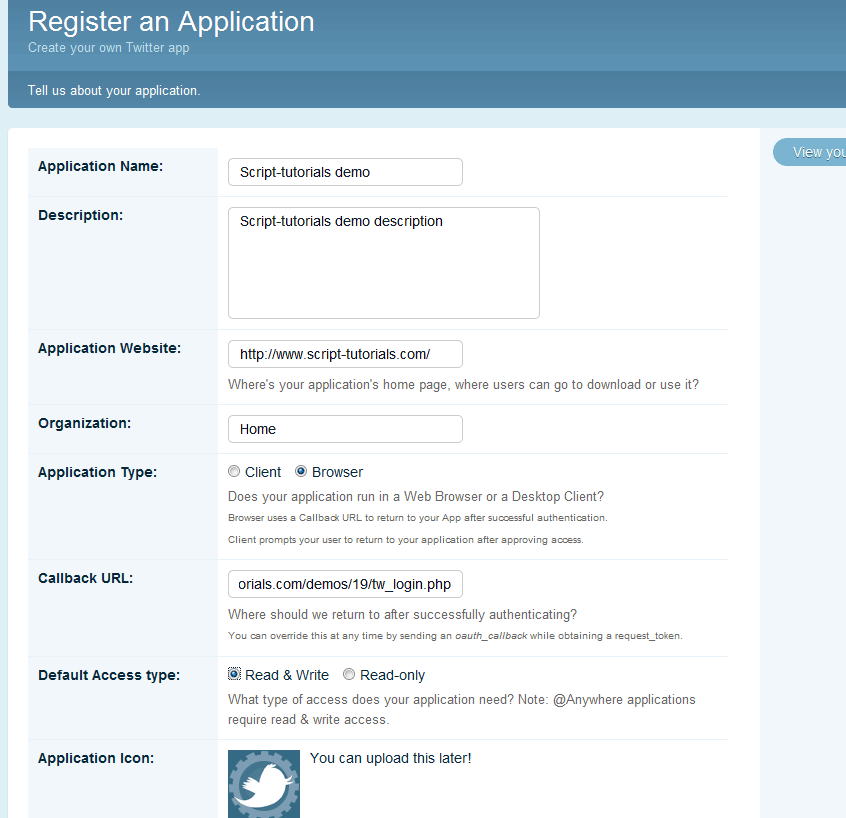Twitter crossposter with OAuth
Recently (seems in august of 2010) Twitter was changed, and now it doesn’t support basic authentication (as usual via CURL), all authentication is done via OAuth.В In this article I made tutorial how to create crossposter to Twitter (using Twitter OAuth).
Step 1. HTML
As usual, we start with the HTML.
I prepared several templates which we will use. First template for guests only.
templates/twitter_login.html
<h3>Hell Guest, <a href="tw_login.php">Login to Twitter</a></h3>Next template – post form for logged members.
templates/twitter_post.html
<h3>Hello @__twitter_name__</h3>
<hr />
<form method="post">
<table>
<tr>
<td valign="top">What`s happening?</td>
<td><textarea name="message" rows="4" cols="75" class="input_area"></textarea></td>
</tr>
<tr>
<td></td>
<td><small>(Twitter will trucate your tweet if your tweet size exceed 140 characters limit.)</small></td>
</tr>
<tr>
<td></td><td><input type="submit" name="post" value="Tweet" /></td>
</tr>
</table>
</form>And last one – nice twitter widget which allow us to see posts of members. We will use it to see out posts.
templates/twitter_widget.html
<img src="https://dev-school.net/logo-tuts.png" alt="logo">
<script src="http://widgets.twimg.com/j/2/widget.js"></script>
<script>
new TWTR.Widget({
version: 2,
type: 'profile',
rpp: 10,
interval: 6000,
width: 'auto',
height: 300,
theme: {
shell: {
background: '#333333',
color: '#ffffff'
},
tweets: {
background: '#000000',
color: '#ffffff',
links: '#4aed05'
}
},
features: {
scrollbar: true,
loop: false,
live: false,
hashtags: true,
timestamp: true,
avatars: true,
behavior: 'all'
}
}).render().setUser('__twitter_name__').start();
</script>Step 2. SQL
We will need to execute next SQL in our database. In this case we will storing oauth info of members.
CREATE TABLE `atwitter_oauth_users` (
`id` int(10) unsigned NOT NULL AUTO_INCREMENT,
`oauth_provider` varchar(10),
`oauth_uid` text,
`oauth_token` text,
`oauth_secret` text,
`username` text,
PRIMARY KEY (`id`)
) ENGINE=MyISAM DEFAULT CHARSET=utf8;Step 3. PHP
Now is most interested, functional itself
Used libraries I put to ‘inc’ folder, this is OAuth.php and twitteroauth.php files. I don`t will include source code of these libraries in this article, here are many code, both libraries located in our package.
Our first file – just config file, containing Twitter consumer Key and Secret plus database details
Important, you will need to register your own application and obtain Twitter consumer key and secret code at http://dev.twitter.com/apps/new
During registering you will need point to callback url (http://www.yoursite.com/tw_login.php), also select ‘Read & Write’ to allow posting to your twitter, next fields like application URL can be like http://www.yoursite.com/
Here are my result with these settings:
inc/header.php
$sConsumerKey = 'YOUR_TWITTER_CONSUMER_KEY';
$sConsumerSecret = 'YOUR_TWITTER_CONSUMER_SECRET';
$sDbName = 'YOUR_DATABASE_NAME';
$sDbUserName = 'YOUR_DATABASE_USERNAME';
$sDbUserPass = 'YOUR_DATABASE_USER_PASS';Next file – our main file. This file will draw ‘Hello guest’ for guests, and when we logged it it will show our posts from Twitter plus form where we can Tweet out thoughts. Hope that code very understandable
index.php
// set error reporting level
if (version_compare(phpversion(), "5.3.0", ">=") == 1)
error_reporting(E_ALL & ~E_NOTICE & ~E_DEPRECATED);
else
error_reporting(E_ALL & ~E_NOTICE);
require_once('inc/header.php');
session_start();
echo '<link rel="stylesheet" href="templates/css/main.css" type="text/css" />';
// cross posting
if($_POST['post']) {
$sPostingRes = "<h3><div class='success'>Your tweet not posted to Twitter (error happen)</div></h3>";
$bPostRes = performTwitterPost($_POST['message']);
if ($bPostRes) {
$sPostingRes = "<h3><div class='success'>Your tweet has posted to Twitter</div></h3>";
}
echo $sPostingRes;
}
if ($_SESSION['oauth_username'] != '') {
$aTmplWidgValues = array(
'__twitter_name__' => $_SESSION['oauth_username']
);
$sFileWidgContent = file_get_contents('templates/twitter_widget.html');
$aWidgKeys = array_keys($aTmplWidgValues);
$aWidgValues = array_values($aTmplWidgValues);
echo str_replace($aWidgKeys, $aWidgValues, $sFileWidgContent); // draw widget
$aTmplFormValues = array(
'__twitter_name__' => $_SESSION['oauth_username']
);
$aFormKeys = array_keys($aTmplFormValues);
$sFileFormContent = file_get_contents('templates/twitter_post.html');
$aFormValues = array_values($aTmplFormValues);
echo str_replace($aFormKeys, $aFormValues, $sFileFormContent); // draw posting form
} else {
require_once('templates/twitter_login.html'); // draw login
}
function performTwitterPost($sMessage) {
global $sConsumerKey, $sConsumerSecret;
require_once('inc/twitteroauth.php');
$oTweet = new TwitterOAuth($sConsumerKey, $sConsumerSecret, $_SESSION['oauth_token'], $_SESSION['oauth_secret']);
$oTweet->post('statuses/update', array('status' => $sMessage));
return true;
}Next two files we will using for authentication of members using TwitterOAuth
tw_login.php
require_once('inc/header.php');
require_once('inc/twitteroauth.php');
global $sConsumerKey, $sConsumerSecret;
session_start();
$oTwitterOauth = new TwitterOAuth($sConsumerKey, $sConsumerSecret);
$aRequestToken = $oTwitterOauth->getRequestToken('http://www.yoursite.com/tw_oauth.php'); // getting authentication tokens
// saving token params into the session
$_SESSION['oauth_token'] = $aRequestToken['oauth_token'];
$_SESSION['oauth_token_secret'] = $aRequestToken['oauth_token_secret'];
if($oTwitterOauth->http_code==200) { // in case of success
$sUrl = $oTwitterOauth->getAuthorizeURL($aRequestToken['oauth_token']); // generate authorization url
header('Location: '. $sUrl); // redirecting
} else {
die('Error happened due authorization');
}require_once('inc/header.php');
require_once('inc/twitteroauth.php');
global $sConsumerKey, $sConsumerSecret;
session_start();
if (! empty($_GET['oauth_verifier']) && ! empty($_SESSION['oauth_token']) && ! empty($_SESSION['oauth_token_secret'])) {
} else { // some params missed, back to login page
header('Location: http://www.yoursite.com/tw_login.php');
}
$oTwitterOauth = new TwitterOAuth($sConsumerKey, $sConsumerSecret, $_SESSION['oauth_token'], $_SESSION['oauth_token_secret']);
$aAccessToken = $oTwitterOauth->getAccessToken($_GET['oauth_verifier']); // get access tokens
$_SESSION['access_token'] = $aAccessToken; // saving access token to sessions
$oUserInfo = $oTwitterOauth->get('account/verify_credentials'); // get account details
if(isset($oUserInfo->error)){
header('Location: http://www.yoursite.com/tw_login.php'); // in case of any errors - back to login page
} else {
global $sDbName, $sDbUserName, $sDbUserPass;
$vLink = mysql_connect('localhost', $sDbUserName, $sDbUserPass);
mysql_select_db($sDbName);
$vOAuth1 = mysql_query("SELECT * FROM `atwitter_oauth_users` WHERE `oauth_provider` = 'twitter' AND `oauth_uid` = '{$oUserInfo->id}'"); // searching for user in database
$aOauthUserInfo = mysql_fetch_array($vOAuth1);
if (empty($aOauthUserInfo)) { // if user info not present - add them into database
mysql_query("INSERT INTO `atwitter_oauth_users` (`oauth_provider`, `oauth_uid`, `username`, `oauth_token`, `oauth_secret`) VALUES ('twitter', {$oUserInfo->id}, '{$oUserInfo->screen_name}', '{$aAccessToken['oauth_token']}', '{$aAccessToken['oauth_token_secret']}')");
$vOAuth2 = mysql_query("SELECT * FROM `atwitter_oauth_users` WHERE `id` = '" . mysql_insert_id() . "'");
$aOauthUserInfo = mysql_fetch_array($vOAuth2);
} else {
mysql_query("UPDATE `atwitter_oauth_users` SET `oauth_token` = '{$aAccessToken['oauth_token']}', `oauth_secret` = '{$aAccessToken['oauth_token_secret']}' WHERE `oauth_provider` = 'twitter' AND `oauth_uid` = '{$oUserInfo->id}'"); // update tokens
}
$_SESSION['oauth_id'] = $aOauthUserInfo['id'];
$_SESSION['oauth_username'] = $aOauthUserInfo['username'];
$_SESSION['oauth_uid'] = $aOauthUserInfo['oauth_uid'];
$_SESSION['oauth_provider'] = $aOauthUserInfo['oauth_provider'];
$_SESSION['oauth_token'] = $aOauthUserInfo['oauth_token'];
$_SESSION['oauth_secret'] = $aOauthUserInfo['oauth_secret'];
mysql_close($vLink);
header('Location: http://www.yoursite.com/index.php');
}
if(!empty($_SESSION['oauth_username'])){
header('Location: http://www.yoursite.com/index.php'); // already logged, back to our main page
}Make attention, that in my article I used ‘http://www.yoursite.com/’, of course you will need apply your own URL
Conclusion
Today we learn not very easy lesson, but very useful. Now we will able to implement this tool into our projects to make it more friendly with another networks like Twitter. Good luck!